Ashford University - Lifter Strategic Plan: Ride-Hailing Services
VerifiedAdded on 2022/12/15
|15
|3532
|221
Project
AI Summary
This project presents a comprehensive strategic plan for Lifter, an online transportation company operating in the ride-hailing market. The plan encompasses an executive summary, mission statement, and detailed overview of the services offered, including Lifter Assist, Lifter Bike, Lifter Comfort, and Lifter Family. It analyzes the competitive landscape, with a focus on major players like Uber, Ola, and Merucab. The situation analysis explores Lifter's market position, strengths, weaknesses, opportunities, and threats (SWOT). Furthermore, the plan includes critical success factors and a Porter's Five Forces analysis to assess the competitive environment. The core of Lifter's strategy revolves around a low-cost pricing model aimed at capturing a significant market share, particularly among lower-income groups in India. The plan emphasizes the importance of customizable services, effective staffing, and strategic marketing to achieve its objectives and consolidate its market position. The analysis also considers factors like increasing oil prices and driver demands, and how Lifter plans to overcome these challenges.

Running Head: Strategic Plan for Lifter
Strategic Plan for Lifter
Kendrick D. Brown
Ashford University
Strategic Plan for Lifter
Kendrick D. Brown
Ashford University
Paraphrase This Document
Need a fresh take? Get an instant paraphrase of this document with our AI Paraphraser
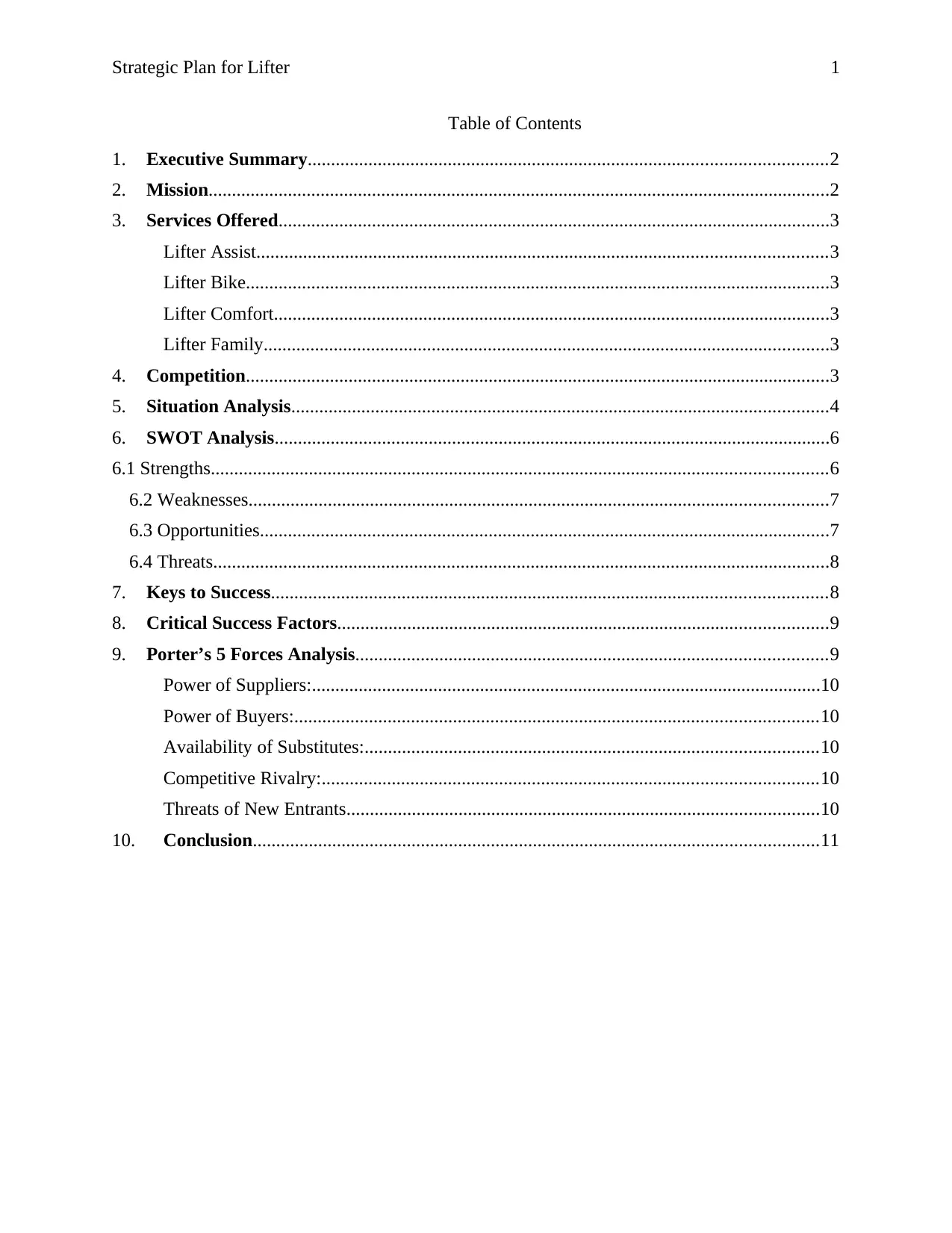
Strategic Plan for Lifter 1
Table of Contents
1. Executive Summary...............................................................................................................2
2. Mission.....................................................................................................................................2
3. Services Offered......................................................................................................................3
Lifter Assist..........................................................................................................................3
Lifter Bike.............................................................................................................................3
Lifter Comfort.......................................................................................................................3
Lifter Family.........................................................................................................................3
4. Competition.............................................................................................................................3
5. Situation Analysis...................................................................................................................4
6. SWOT Analysis.......................................................................................................................6
6.1 Strengths....................................................................................................................................6
6.2 Weaknesses............................................................................................................................7
6.3 Opportunities..........................................................................................................................7
6.4 Threats....................................................................................................................................8
7. Keys to Success.......................................................................................................................8
8. Critical Success Factors.........................................................................................................9
9. Porter’s 5 Forces Analysis.....................................................................................................9
Power of Suppliers:.............................................................................................................10
Power of Buyers:................................................................................................................10
Availability of Substitutes:.................................................................................................10
Competitive Rivalry:..........................................................................................................10
Threats of New Entrants.....................................................................................................10
10. Conclusion.........................................................................................................................11
Table of Contents
1. Executive Summary...............................................................................................................2
2. Mission.....................................................................................................................................2
3. Services Offered......................................................................................................................3
Lifter Assist..........................................................................................................................3
Lifter Bike.............................................................................................................................3
Lifter Comfort.......................................................................................................................3
Lifter Family.........................................................................................................................3
4. Competition.............................................................................................................................3
5. Situation Analysis...................................................................................................................4
6. SWOT Analysis.......................................................................................................................6
6.1 Strengths....................................................................................................................................6
6.2 Weaknesses............................................................................................................................7
6.3 Opportunities..........................................................................................................................7
6.4 Threats....................................................................................................................................8
7. Keys to Success.......................................................................................................................8
8. Critical Success Factors.........................................................................................................9
9. Porter’s 5 Forces Analysis.....................................................................................................9
Power of Suppliers:.............................................................................................................10
Power of Buyers:................................................................................................................10
Availability of Substitutes:.................................................................................................10
Competitive Rivalry:..........................................................................................................10
Threats of New Entrants.....................................................................................................10
10. Conclusion.........................................................................................................................11
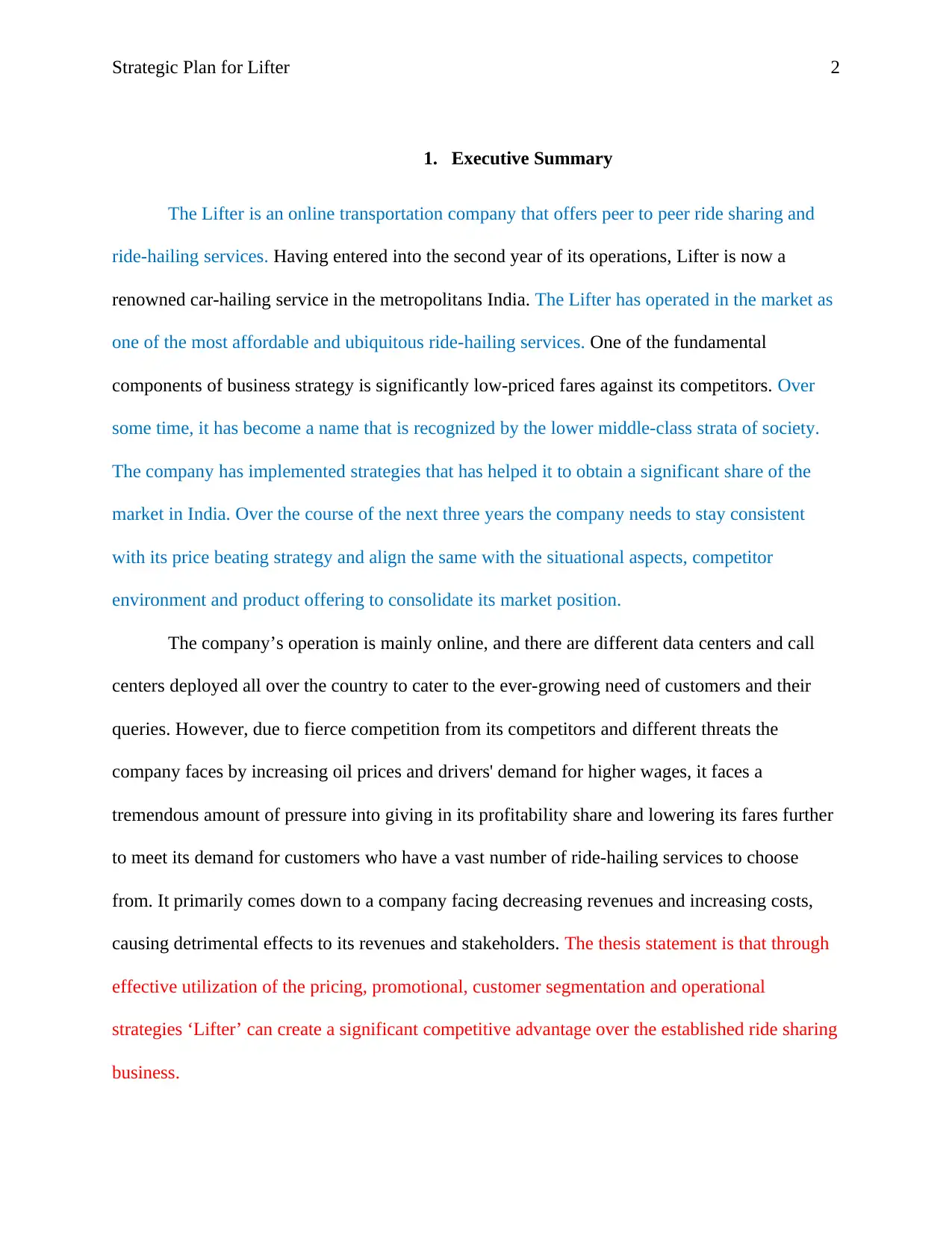
Strategic Plan for Lifter 2
1. Executive Summary
The Lifter is an online transportation company that offers peer to peer ride sharing and
ride-hailing services. Having entered into the second year of its operations, Lifter is now a
renowned car-hailing service in the metropolitans India. The Lifter has operated in the market as
one of the most affordable and ubiquitous ride-hailing services. One of the fundamental
components of business strategy is significantly low-priced fares against its competitors. Over
some time, it has become a name that is recognized by the lower middle-class strata of society.
The company has implemented strategies that has helped it to obtain a significant share of the
market in India. Over the course of the next three years the company needs to stay consistent
with its price beating strategy and align the same with the situational aspects, competitor
environment and product offering to consolidate its market position.
The company’s operation is mainly online, and there are different data centers and call
centers deployed all over the country to cater to the ever-growing need of customers and their
queries. However, due to fierce competition from its competitors and different threats the
company faces by increasing oil prices and drivers' demand for higher wages, it faces a
tremendous amount of pressure into giving in its profitability share and lowering its fares further
to meet its demand for customers who have a vast number of ride-hailing services to choose
from. It primarily comes down to a company facing decreasing revenues and increasing costs,
causing detrimental effects to its revenues and stakeholders. The thesis statement is that through
effective utilization of the pricing, promotional, customer segmentation and operational
strategies ‘Lifter’ can create a significant competitive advantage over the established ride sharing
business.
1. Executive Summary
The Lifter is an online transportation company that offers peer to peer ride sharing and
ride-hailing services. Having entered into the second year of its operations, Lifter is now a
renowned car-hailing service in the metropolitans India. The Lifter has operated in the market as
one of the most affordable and ubiquitous ride-hailing services. One of the fundamental
components of business strategy is significantly low-priced fares against its competitors. Over
some time, it has become a name that is recognized by the lower middle-class strata of society.
The company has implemented strategies that has helped it to obtain a significant share of the
market in India. Over the course of the next three years the company needs to stay consistent
with its price beating strategy and align the same with the situational aspects, competitor
environment and product offering to consolidate its market position.
The company’s operation is mainly online, and there are different data centers and call
centers deployed all over the country to cater to the ever-growing need of customers and their
queries. However, due to fierce competition from its competitors and different threats the
company faces by increasing oil prices and drivers' demand for higher wages, it faces a
tremendous amount of pressure into giving in its profitability share and lowering its fares further
to meet its demand for customers who have a vast number of ride-hailing services to choose
from. It primarily comes down to a company facing decreasing revenues and increasing costs,
causing detrimental effects to its revenues and stakeholders. The thesis statement is that through
effective utilization of the pricing, promotional, customer segmentation and operational
strategies ‘Lifter’ can create a significant competitive advantage over the established ride sharing
business.
⊘ This is a preview!⊘
Do you want full access?
Subscribe today to unlock all pages.

Trusted by 1+ million students worldwide
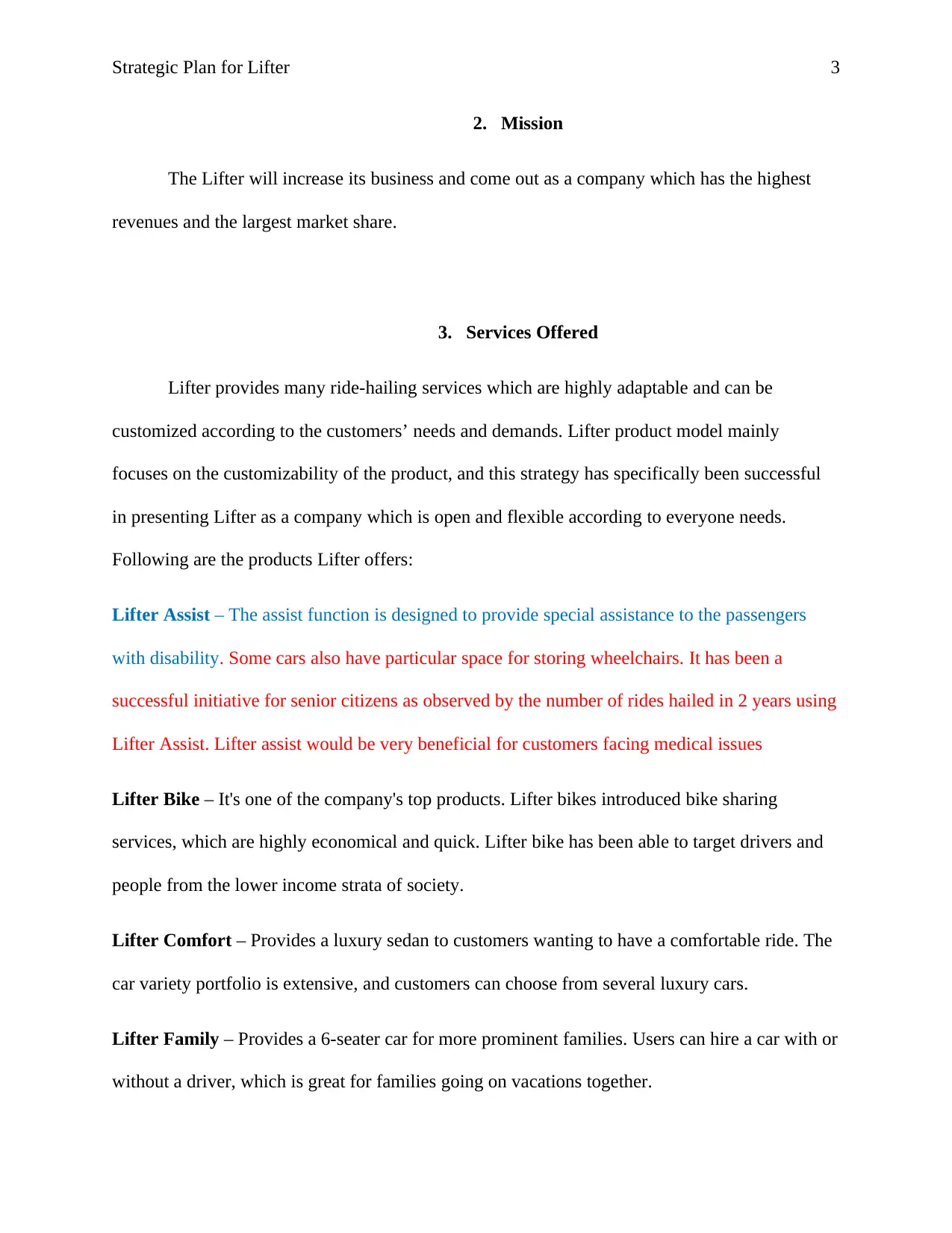
Strategic Plan for Lifter 3
2. Mission
The Lifter will increase its business and come out as a company which has the highest
revenues and the largest market share.
3. Services Offered
Lifter provides many ride-hailing services which are highly adaptable and can be
customized according to the customers’ needs and demands. Lifter product model mainly
focuses on the customizability of the product, and this strategy has specifically been successful
in presenting Lifter as a company which is open and flexible according to everyone needs.
Following are the products Lifter offers:
Lifter Assist – The assist function is designed to provide special assistance to the passengers
with disability. Some cars also have particular space for storing wheelchairs. It has been a
successful initiative for senior citizens as observed by the number of rides hailed in 2 years using
Lifter Assist. Lifter assist would be very beneficial for customers facing medical issues
Lifter Bike – It's one of the company's top products. Lifter bikes introduced bike sharing
services, which are highly economical and quick. Lifter bike has been able to target drivers and
people from the lower income strata of society.
Lifter Comfort – Provides a luxury sedan to customers wanting to have a comfortable ride. The
car variety portfolio is extensive, and customers can choose from several luxury cars.
Lifter Family – Provides a 6-seater car for more prominent families. Users can hire a car with or
without a driver, which is great for families going on vacations together.
2. Mission
The Lifter will increase its business and come out as a company which has the highest
revenues and the largest market share.
3. Services Offered
Lifter provides many ride-hailing services which are highly adaptable and can be
customized according to the customers’ needs and demands. Lifter product model mainly
focuses on the customizability of the product, and this strategy has specifically been successful
in presenting Lifter as a company which is open and flexible according to everyone needs.
Following are the products Lifter offers:
Lifter Assist – The assist function is designed to provide special assistance to the passengers
with disability. Some cars also have particular space for storing wheelchairs. It has been a
successful initiative for senior citizens as observed by the number of rides hailed in 2 years using
Lifter Assist. Lifter assist would be very beneficial for customers facing medical issues
Lifter Bike – It's one of the company's top products. Lifter bikes introduced bike sharing
services, which are highly economical and quick. Lifter bike has been able to target drivers and
people from the lower income strata of society.
Lifter Comfort – Provides a luxury sedan to customers wanting to have a comfortable ride. The
car variety portfolio is extensive, and customers can choose from several luxury cars.
Lifter Family – Provides a 6-seater car for more prominent families. Users can hire a car with or
without a driver, which is great for families going on vacations together.
Paraphrase This Document
Need a fresh take? Get an instant paraphrase of this document with our AI Paraphraser
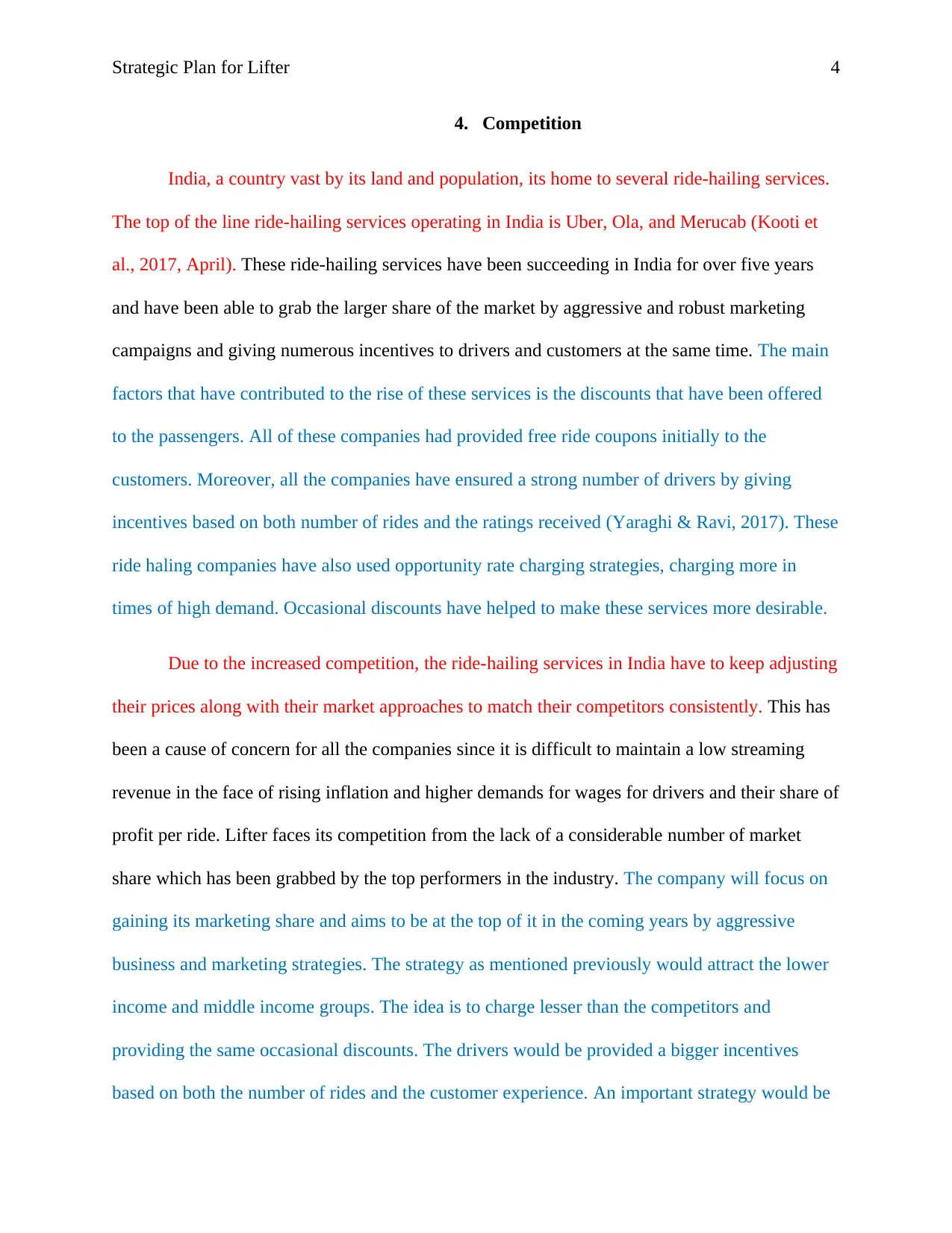
Strategic Plan for Lifter 4
4. Competition
India, a country vast by its land and population, its home to several ride-hailing services.
The top of the line ride-hailing services operating in India is Uber, Ola, and Merucab (Kooti et
al., 2017, April). These ride-hailing services have been succeeding in India for over five years
and have been able to grab the larger share of the market by aggressive and robust marketing
campaigns and giving numerous incentives to drivers and customers at the same time. The main
factors that have contributed to the rise of these services is the discounts that have been offered
to the passengers. All of these companies had provided free ride coupons initially to the
customers. Moreover, all the companies have ensured a strong number of drivers by giving
incentives based on both number of rides and the ratings received (Yaraghi & Ravi, 2017). These
ride haling companies have also used opportunity rate charging strategies, charging more in
times of high demand. Occasional discounts have helped to make these services more desirable.
Due to the increased competition, the ride-hailing services in India have to keep adjusting
their prices along with their market approaches to match their competitors consistently. This has
been a cause of concern for all the companies since it is difficult to maintain a low streaming
revenue in the face of rising inflation and higher demands for wages for drivers and their share of
profit per ride. Lifter faces its competition from the lack of a considerable number of market
share which has been grabbed by the top performers in the industry. The company will focus on
gaining its marketing share and aims to be at the top of it in the coming years by aggressive
business and marketing strategies. The strategy as mentioned previously would attract the lower
income and middle income groups. The idea is to charge lesser than the competitors and
providing the same occasional discounts. The drivers would be provided a bigger incentives
based on both the number of rides and the customer experience. An important strategy would be
4. Competition
India, a country vast by its land and population, its home to several ride-hailing services.
The top of the line ride-hailing services operating in India is Uber, Ola, and Merucab (Kooti et
al., 2017, April). These ride-hailing services have been succeeding in India for over five years
and have been able to grab the larger share of the market by aggressive and robust marketing
campaigns and giving numerous incentives to drivers and customers at the same time. The main
factors that have contributed to the rise of these services is the discounts that have been offered
to the passengers. All of these companies had provided free ride coupons initially to the
customers. Moreover, all the companies have ensured a strong number of drivers by giving
incentives based on both number of rides and the ratings received (Yaraghi & Ravi, 2017). These
ride haling companies have also used opportunity rate charging strategies, charging more in
times of high demand. Occasional discounts have helped to make these services more desirable.
Due to the increased competition, the ride-hailing services in India have to keep adjusting
their prices along with their market approaches to match their competitors consistently. This has
been a cause of concern for all the companies since it is difficult to maintain a low streaming
revenue in the face of rising inflation and higher demands for wages for drivers and their share of
profit per ride. Lifter faces its competition from the lack of a considerable number of market
share which has been grabbed by the top performers in the industry. The company will focus on
gaining its marketing share and aims to be at the top of it in the coming years by aggressive
business and marketing strategies. The strategy as mentioned previously would attract the lower
income and middle income groups. The idea is to charge lesser than the competitors and
providing the same occasional discounts. The drivers would be provided a bigger incentives
based on both the number of rides and the customer experience. An important strategy would be

Strategic Plan for Lifter 5
to charge lesser rates than the competitors even during times of high demand such as rain or
storm, extreme weather, public transport strikes, late hours or other forms of high demand
transportation situations. The strategies are aimed towards gaining the lower income customer
base in India. This would help to strengthen the market position of the organization.
5. Situation Analysis
As Lifter now enters in its second year of operations, it aims to be at the top of the ride-
sharing industry. It wants to do so by opting for various strategic plans. Lifter’s top competitive
advantage in the market has been its low-cost pricing strategy which has born positive results for
the company. Its product portfolio has been relatively minimal as compared to its competitors,
but products like Lifter Assist has been one of its most successful products to ever launch in
India's ride haling services industry. The market currently is offering various products ranging
from food delivery services to courier delivery services under the domain of ride sharing. This
has been a tough call for Lifter as entering into a new domain calls for unique risks, and the
success of product largely depends on the users and how well they receive it. The market is
increasing in terms of value and quality but needs to be realized fast.
The market is currently lucrative but also coming to a saturation point. Top companies
have had large footprints in terms of their operations in the country. The number of drivers
availing the business opportunity, and the consumers is growing every day, yet there is a mostly
untapped market, which does not use ride-hailing services as their daily routine. Either it is
because they have other means of transportation at hands like having a motorbike or using public
transport or the prices the ride-hailing services offered are usually out of the reach of an average
customer. Lifter believes in tapping the market which has yet explored its full potential. It aims
to target the lower income strata of the country, which constitutes about 70 to 80 percent of the
to charge lesser rates than the competitors even during times of high demand such as rain or
storm, extreme weather, public transport strikes, late hours or other forms of high demand
transportation situations. The strategies are aimed towards gaining the lower income customer
base in India. This would help to strengthen the market position of the organization.
5. Situation Analysis
As Lifter now enters in its second year of operations, it aims to be at the top of the ride-
sharing industry. It wants to do so by opting for various strategic plans. Lifter’s top competitive
advantage in the market has been its low-cost pricing strategy which has born positive results for
the company. Its product portfolio has been relatively minimal as compared to its competitors,
but products like Lifter Assist has been one of its most successful products to ever launch in
India's ride haling services industry. The market currently is offering various products ranging
from food delivery services to courier delivery services under the domain of ride sharing. This
has been a tough call for Lifter as entering into a new domain calls for unique risks, and the
success of product largely depends on the users and how well they receive it. The market is
increasing in terms of value and quality but needs to be realized fast.
The market is currently lucrative but also coming to a saturation point. Top companies
have had large footprints in terms of their operations in the country. The number of drivers
availing the business opportunity, and the consumers is growing every day, yet there is a mostly
untapped market, which does not use ride-hailing services as their daily routine. Either it is
because they have other means of transportation at hands like having a motorbike or using public
transport or the prices the ride-hailing services offered are usually out of the reach of an average
customer. Lifter believes in tapping the market which has yet explored its full potential. It aims
to target the lower income strata of the country, which constitutes about 70 to 80 percent of the
⊘ This is a preview!⊘
Do you want full access?
Subscribe today to unlock all pages.

Trusted by 1+ million students worldwide
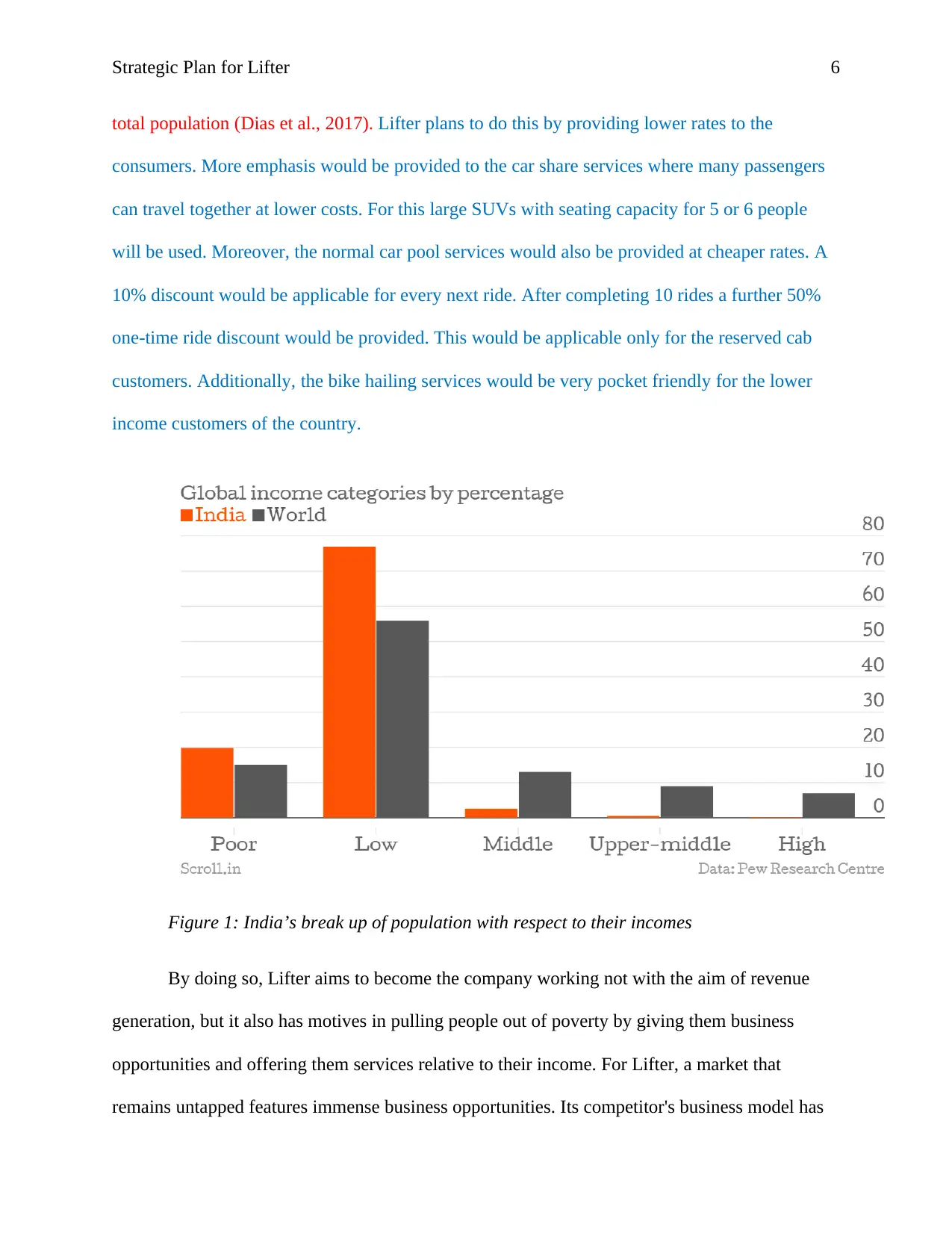
Strategic Plan for Lifter 6
total population (Dias et al., 2017). Lifter plans to do this by providing lower rates to the
consumers. More emphasis would be provided to the car share services where many passengers
can travel together at lower costs. For this large SUVs with seating capacity for 5 or 6 people
will be used. Moreover, the normal car pool services would also be provided at cheaper rates. A
10% discount would be applicable for every next ride. After completing 10 rides a further 50%
one-time ride discount would be provided. This would be applicable only for the reserved cab
customers. Additionally, the bike hailing services would be very pocket friendly for the lower
income customers of the country.
Figure 1: India’s break up of population with respect to their incomes
By doing so, Lifter aims to become the company working not with the aim of revenue
generation, but it also has motives in pulling people out of poverty by giving them business
opportunities and offering them services relative to their income. For Lifter, a market that
remains untapped features immense business opportunities. Its competitor's business model has
total population (Dias et al., 2017). Lifter plans to do this by providing lower rates to the
consumers. More emphasis would be provided to the car share services where many passengers
can travel together at lower costs. For this large SUVs with seating capacity for 5 or 6 people
will be used. Moreover, the normal car pool services would also be provided at cheaper rates. A
10% discount would be applicable for every next ride. After completing 10 rides a further 50%
one-time ride discount would be provided. This would be applicable only for the reserved cab
customers. Additionally, the bike hailing services would be very pocket friendly for the lower
income customers of the country.
Figure 1: India’s break up of population with respect to their incomes
By doing so, Lifter aims to become the company working not with the aim of revenue
generation, but it also has motives in pulling people out of poverty by giving them business
opportunities and offering them services relative to their income. For Lifter, a market that
remains untapped features immense business opportunities. Its competitor's business model has
Paraphrase This Document
Need a fresh take? Get an instant paraphrase of this document with our AI Paraphraser
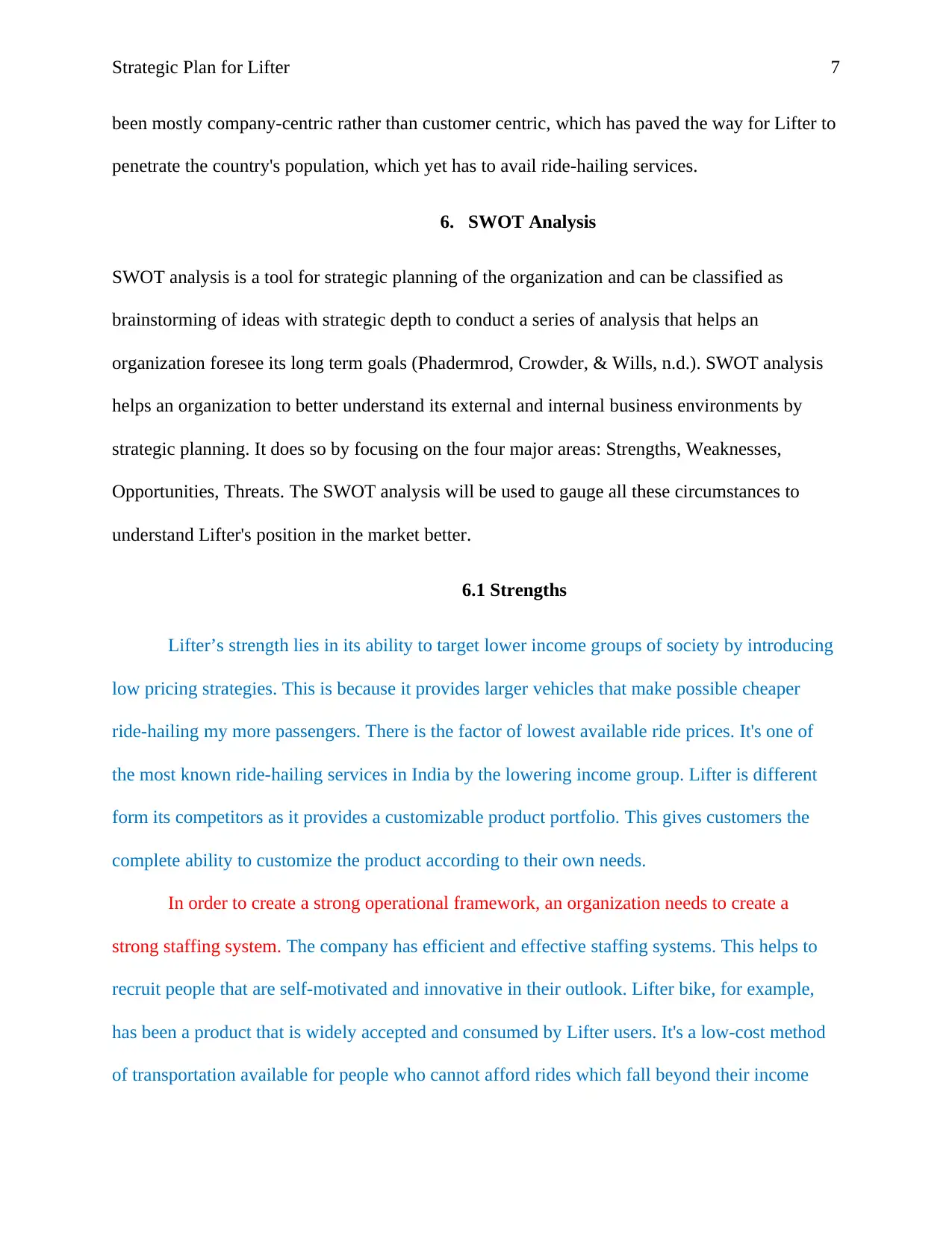
Strategic Plan for Lifter 7
been mostly company-centric rather than customer centric, which has paved the way for Lifter to
penetrate the country's population, which yet has to avail ride-hailing services.
6. SWOT Analysis
SWOT analysis is a tool for strategic planning of the organization and can be classified as
brainstorming of ideas with strategic depth to conduct a series of analysis that helps an
organization foresee its long term goals (Phadermrod, Crowder, & Wills, n.d.). SWOT analysis
helps an organization to better understand its external and internal business environments by
strategic planning. It does so by focusing on the four major areas: Strengths, Weaknesses,
Opportunities, Threats. The SWOT analysis will be used to gauge all these circumstances to
understand Lifter's position in the market better.
6.1 Strengths
Lifter’s strength lies in its ability to target lower income groups of society by introducing
low pricing strategies. This is because it provides larger vehicles that make possible cheaper
ride-hailing my more passengers. There is the factor of lowest available ride prices. It's one of
the most known ride-hailing services in India by the lowering income group. Lifter is different
form its competitors as it provides a customizable product portfolio. This gives customers the
complete ability to customize the product according to their own needs.
In order to create a strong operational framework, an organization needs to create a
strong staffing system. The company has efficient and effective staffing systems. This helps to
recruit people that are self-motivated and innovative in their outlook. Lifter bike, for example,
has been a product that is widely accepted and consumed by Lifter users. It's a low-cost method
of transportation available for people who cannot afford rides which fall beyond their income
been mostly company-centric rather than customer centric, which has paved the way for Lifter to
penetrate the country's population, which yet has to avail ride-hailing services.
6. SWOT Analysis
SWOT analysis is a tool for strategic planning of the organization and can be classified as
brainstorming of ideas with strategic depth to conduct a series of analysis that helps an
organization foresee its long term goals (Phadermrod, Crowder, & Wills, n.d.). SWOT analysis
helps an organization to better understand its external and internal business environments by
strategic planning. It does so by focusing on the four major areas: Strengths, Weaknesses,
Opportunities, Threats. The SWOT analysis will be used to gauge all these circumstances to
understand Lifter's position in the market better.
6.1 Strengths
Lifter’s strength lies in its ability to target lower income groups of society by introducing
low pricing strategies. This is because it provides larger vehicles that make possible cheaper
ride-hailing my more passengers. There is the factor of lowest available ride prices. It's one of
the most known ride-hailing services in India by the lowering income group. Lifter is different
form its competitors as it provides a customizable product portfolio. This gives customers the
complete ability to customize the product according to their own needs.
In order to create a strong operational framework, an organization needs to create a
strong staffing system. The company has efficient and effective staffing systems. This helps to
recruit people that are self-motivated and innovative in their outlook. Lifter bike, for example,
has been a product that is widely accepted and consumed by Lifter users. It's a low-cost method
of transportation available for people who cannot afford rides which fall beyond their income
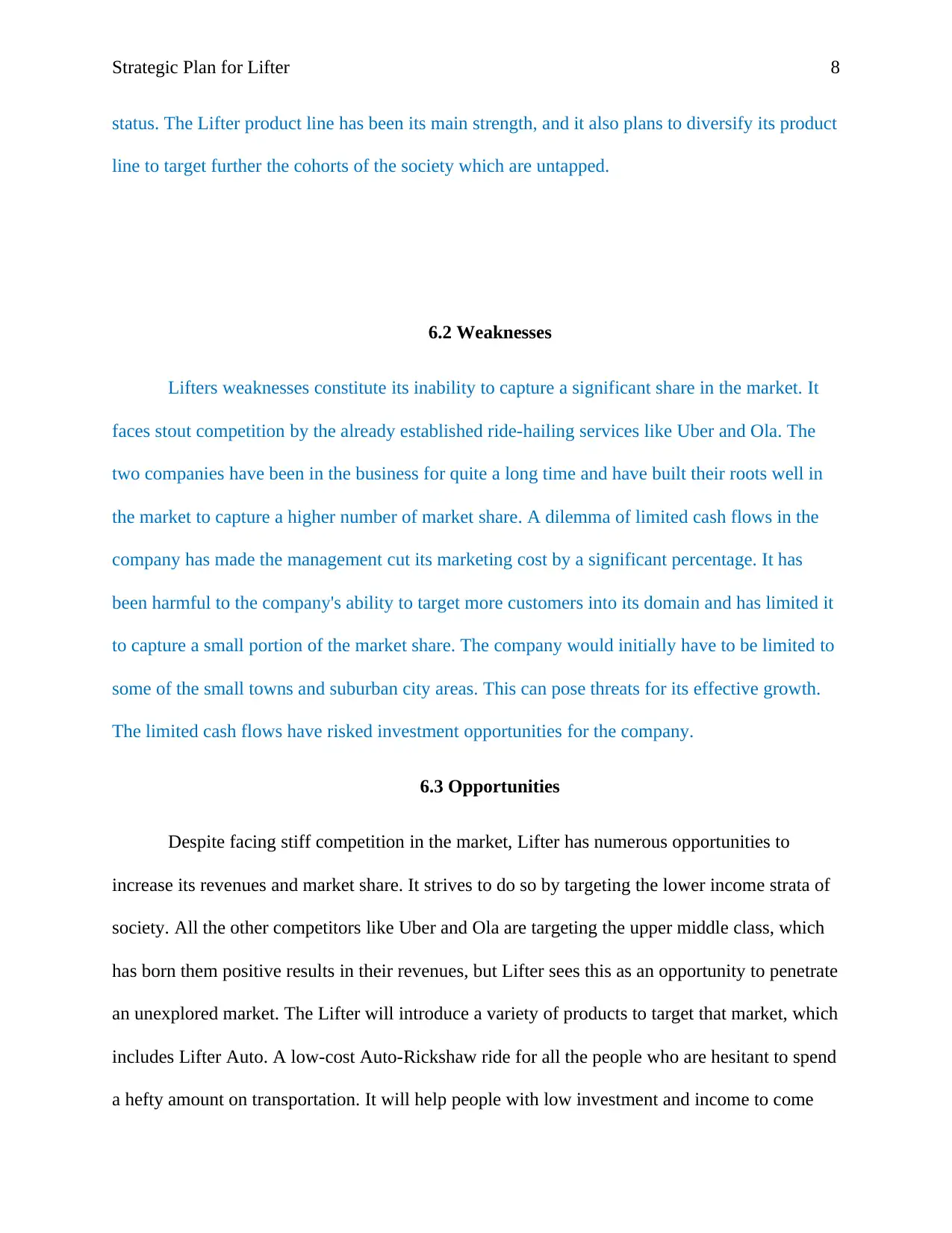
Strategic Plan for Lifter 8
status. The Lifter product line has been its main strength, and it also plans to diversify its product
line to target further the cohorts of the society which are untapped.
6.2 Weaknesses
Lifters weaknesses constitute its inability to capture a significant share in the market. It
faces stout competition by the already established ride-hailing services like Uber and Ola. The
two companies have been in the business for quite a long time and have built their roots well in
the market to capture a higher number of market share. A dilemma of limited cash flows in the
company has made the management cut its marketing cost by a significant percentage. It has
been harmful to the company's ability to target more customers into its domain and has limited it
to capture a small portion of the market share. The company would initially have to be limited to
some of the small towns and suburban city areas. This can pose threats for its effective growth.
The limited cash flows have risked investment opportunities for the company.
6.3 Opportunities
Despite facing stiff competition in the market, Lifter has numerous opportunities to
increase its revenues and market share. It strives to do so by targeting the lower income strata of
society. All the other competitors like Uber and Ola are targeting the upper middle class, which
has born them positive results in their revenues, but Lifter sees this as an opportunity to penetrate
an unexplored market. The Lifter will introduce a variety of products to target that market, which
includes Lifter Auto. A low-cost Auto-Rickshaw ride for all the people who are hesitant to spend
a hefty amount on transportation. It will help people with low investment and income to come
status. The Lifter product line has been its main strength, and it also plans to diversify its product
line to target further the cohorts of the society which are untapped.
6.2 Weaknesses
Lifters weaknesses constitute its inability to capture a significant share in the market. It
faces stout competition by the already established ride-hailing services like Uber and Ola. The
two companies have been in the business for quite a long time and have built their roots well in
the market to capture a higher number of market share. A dilemma of limited cash flows in the
company has made the management cut its marketing cost by a significant percentage. It has
been harmful to the company's ability to target more customers into its domain and has limited it
to capture a small portion of the market share. The company would initially have to be limited to
some of the small towns and suburban city areas. This can pose threats for its effective growth.
The limited cash flows have risked investment opportunities for the company.
6.3 Opportunities
Despite facing stiff competition in the market, Lifter has numerous opportunities to
increase its revenues and market share. It strives to do so by targeting the lower income strata of
society. All the other competitors like Uber and Ola are targeting the upper middle class, which
has born them positive results in their revenues, but Lifter sees this as an opportunity to penetrate
an unexplored market. The Lifter will introduce a variety of products to target that market, which
includes Lifter Auto. A low-cost Auto-Rickshaw ride for all the people who are hesitant to spend
a hefty amount on transportation. It will help people with low investment and income to come
⊘ This is a preview!⊘
Do you want full access?
Subscribe today to unlock all pages.

Trusted by 1+ million students worldwide
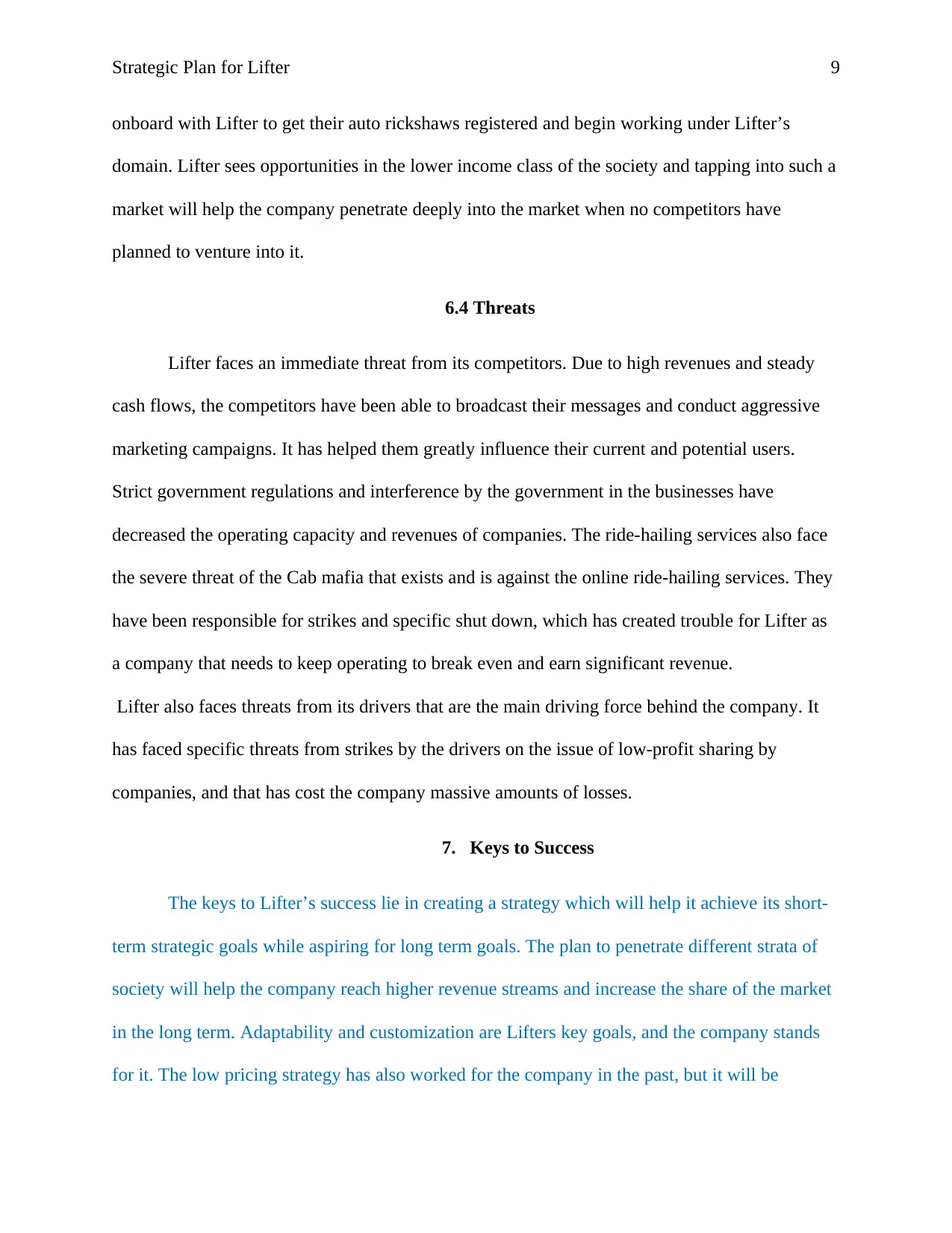
Strategic Plan for Lifter 9
onboard with Lifter to get their auto rickshaws registered and begin working under Lifter’s
domain. Lifter sees opportunities in the lower income class of the society and tapping into such a
market will help the company penetrate deeply into the market when no competitors have
planned to venture into it.
6.4 Threats
Lifter faces an immediate threat from its competitors. Due to high revenues and steady
cash flows, the competitors have been able to broadcast their messages and conduct aggressive
marketing campaigns. It has helped them greatly influence their current and potential users.
Strict government regulations and interference by the government in the businesses have
decreased the operating capacity and revenues of companies. The ride-hailing services also face
the severe threat of the Cab mafia that exists and is against the online ride-hailing services. They
have been responsible for strikes and specific shut down, which has created trouble for Lifter as
a company that needs to keep operating to break even and earn significant revenue.
Lifter also faces threats from its drivers that are the main driving force behind the company. It
has faced specific threats from strikes by the drivers on the issue of low-profit sharing by
companies, and that has cost the company massive amounts of losses.
7. Keys to Success
The keys to Lifter’s success lie in creating a strategy which will help it achieve its short-
term strategic goals while aspiring for long term goals. The plan to penetrate different strata of
society will help the company reach higher revenue streams and increase the share of the market
in the long term. Adaptability and customization are Lifters key goals, and the company stands
for it. The low pricing strategy has also worked for the company in the past, but it will be
onboard with Lifter to get their auto rickshaws registered and begin working under Lifter’s
domain. Lifter sees opportunities in the lower income class of the society and tapping into such a
market will help the company penetrate deeply into the market when no competitors have
planned to venture into it.
6.4 Threats
Lifter faces an immediate threat from its competitors. Due to high revenues and steady
cash flows, the competitors have been able to broadcast their messages and conduct aggressive
marketing campaigns. It has helped them greatly influence their current and potential users.
Strict government regulations and interference by the government in the businesses have
decreased the operating capacity and revenues of companies. The ride-hailing services also face
the severe threat of the Cab mafia that exists and is against the online ride-hailing services. They
have been responsible for strikes and specific shut down, which has created trouble for Lifter as
a company that needs to keep operating to break even and earn significant revenue.
Lifter also faces threats from its drivers that are the main driving force behind the company. It
has faced specific threats from strikes by the drivers on the issue of low-profit sharing by
companies, and that has cost the company massive amounts of losses.
7. Keys to Success
The keys to Lifter’s success lie in creating a strategy which will help it achieve its short-
term strategic goals while aspiring for long term goals. The plan to penetrate different strata of
society will help the company reach higher revenue streams and increase the share of the market
in the long term. Adaptability and customization are Lifters key goals, and the company stands
for it. The low pricing strategy has also worked for the company in the past, but it will be
Paraphrase This Document
Need a fresh take? Get an instant paraphrase of this document with our AI Paraphraser

Strategic Plan for Lifter 10
difficult to sustain that method as the revenues are continually falling, the company will
negotiate with its workers to minimize their profit share so the company can have cash flows and
it can further invest that money into different ventures. This can help to form some of the critical
success factors going forward.
8. Critical Success Factors
Critical success factors determine the overall success of any organization over longer
periods of time. The critical success factors include the company’s ability to budget its marketing
strategies and create a lucrative and designate a large sum of funds to its marketing team. This
can help the company to establish a strong marketing and promotional framework that can help
to target the specific target audiences. This will help to actually gain a large share of the market
that consists of the lower and middle income groups. Other success factors include the
company's ability to negotiate with its workers for a tolerant profit-sharing ratio to further
enhance its revenues. Having a more tolerant revenue sharing system has recently helped Uber to
create a strong marketing advantage over the longer established Ola. Similarly the profit sharing
ratio can help the organization to create a smooth framework to capitalize on the profitability.
Another key success factor would be the number of passengers. The number of passengers
determine the profitability of these services. In essence, a larger customer base can help the
organization to reap better rewards.
9. Porter’s 5 Forces Analysis
difficult to sustain that method as the revenues are continually falling, the company will
negotiate with its workers to minimize their profit share so the company can have cash flows and
it can further invest that money into different ventures. This can help to form some of the critical
success factors going forward.
8. Critical Success Factors
Critical success factors determine the overall success of any organization over longer
periods of time. The critical success factors include the company’s ability to budget its marketing
strategies and create a lucrative and designate a large sum of funds to its marketing team. This
can help the company to establish a strong marketing and promotional framework that can help
to target the specific target audiences. This will help to actually gain a large share of the market
that consists of the lower and middle income groups. Other success factors include the
company's ability to negotiate with its workers for a tolerant profit-sharing ratio to further
enhance its revenues. Having a more tolerant revenue sharing system has recently helped Uber to
create a strong marketing advantage over the longer established Ola. Similarly the profit sharing
ratio can help the organization to create a smooth framework to capitalize on the profitability.
Another key success factor would be the number of passengers. The number of passengers
determine the profitability of these services. In essence, a larger customer base can help the
organization to reap better rewards.
9. Porter’s 5 Forces Analysis
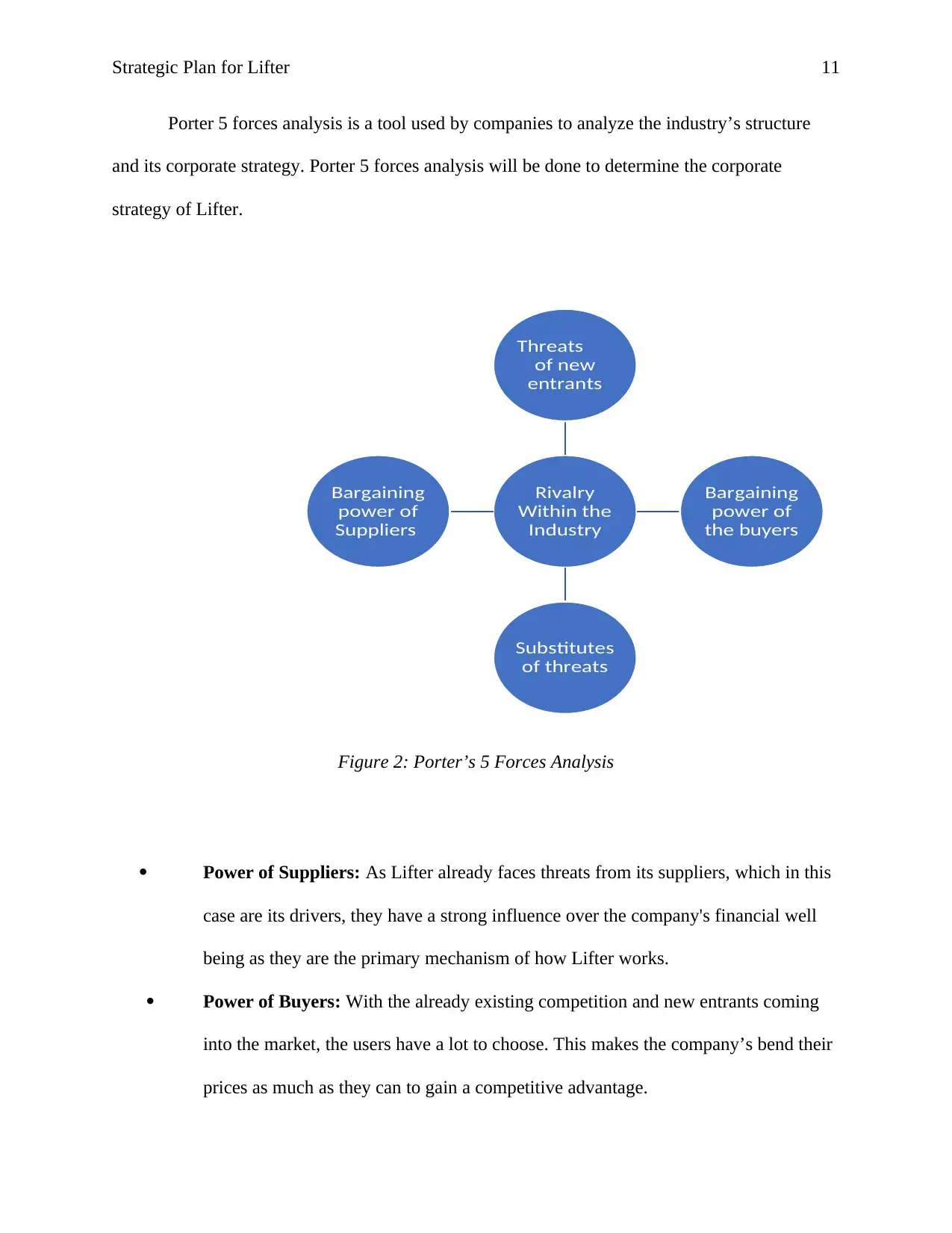
Strategic Plan for Lifter 11
Porter 5 forces analysis is a tool used by companies to analyze the industry’s structure
and its corporate strategy. Porter 5 forces analysis will be done to determine the corporate
strategy of Lifter.
Figure 2: Porter’s 5 Forces Analysis
Power of Suppliers: As Lifter already faces threats from its suppliers, which in this
case are its drivers, they have a strong influence over the company's financial well
being as they are the primary mechanism of how Lifter works.
Power of Buyers: With the already existing competition and new entrants coming
into the market, the users have a lot to choose. This makes the company’s bend their
prices as much as they can to gain a competitive advantage.
Rivalry
Within the
Industry
Threats
of new
entrants
Bargaining
power of
the buyers
Substitutes
of threats
Bargaining
power of
Suppliers
Porter 5 forces analysis is a tool used by companies to analyze the industry’s structure
and its corporate strategy. Porter 5 forces analysis will be done to determine the corporate
strategy of Lifter.
Figure 2: Porter’s 5 Forces Analysis
Power of Suppliers: As Lifter already faces threats from its suppliers, which in this
case are its drivers, they have a strong influence over the company's financial well
being as they are the primary mechanism of how Lifter works.
Power of Buyers: With the already existing competition and new entrants coming
into the market, the users have a lot to choose. This makes the company’s bend their
prices as much as they can to gain a competitive advantage.
Rivalry
Within the
Industry
Threats
of new
entrants
Bargaining
power of
the buyers
Substitutes
of threats
Bargaining
power of
Suppliers
⊘ This is a preview!⊘
Do you want full access?
Subscribe today to unlock all pages.

Trusted by 1+ million students worldwide
1 out of 15
Related Documents
Your All-in-One AI-Powered Toolkit for Academic Success.
+13062052269
info@desklib.com
Available 24*7 on WhatsApp / Email
![[object Object]](/_next/static/media/star-bottom.7253800d.svg)
Unlock your academic potential
Copyright © 2020–2025 A2Z Services. All Rights Reserved. Developed and managed by ZUCOL.




